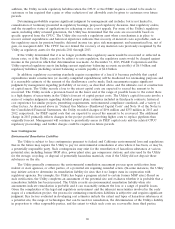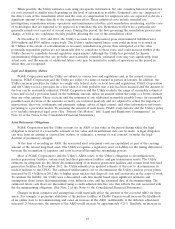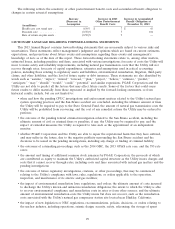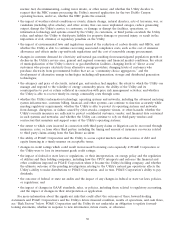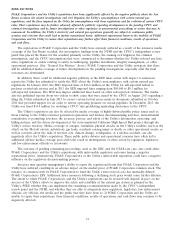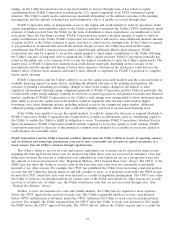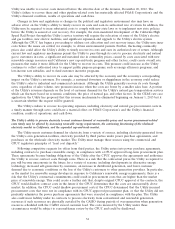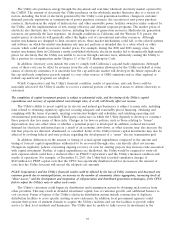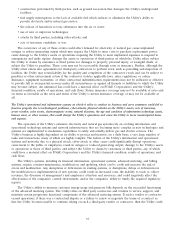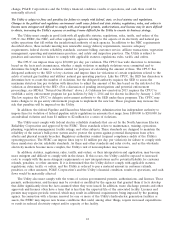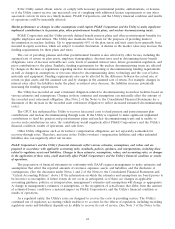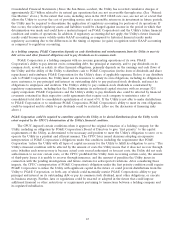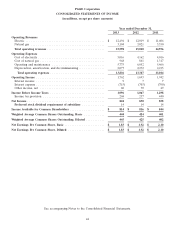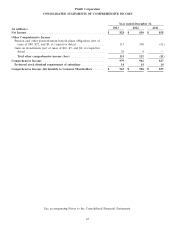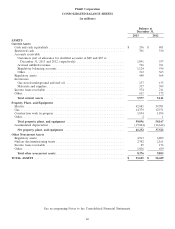PG&E 2013 Annual Report Download - page 42
Download and view the complete annual report
Please find page 42 of the 2013 PG&E annual report below. You can navigate through the pages in the report by either clicking on the pages listed below, or by using the keyword search tool below to find specific information within the annual report.distribution assets that it no longer owns. The Utility’s natural gas transmission facilities could be bypassed by
interstate pipeline companies that construct facilities in the Utility’s markets, by customers who build pipeline
connections that bypass the Utility’s natural gas transmission and distribution system, or by customers who use and
transport liquefied natural gas.
Alternatively, the Utility’s customers could become direct access customers who purchase electricity from
alternative energy suppliers or they could become customers of governmental bodies registered as community choice
aggregators to purchase and sell electricity for their residents and businesses. Although the Utility is permitted to
collect a non-bypassable charge for generation-related costs incurred on behalf of these customers, or distribution,
metering, or other services it continues to provide, the fee may not be sufficient for the Utility to fully recover the
costs to provide these services. Furthermore, if the former customers return to receiving electricity supply from the
Utility, the Utility could incur costs to meet their electricity needs that it may not be able to timely recover through
rates or that it may not be able to recover at all.
In addition, increasing levels of self-generation of electricity by customers (primarily solar installations) and the
use of customer net energy metering, which allows self-generating customers to receive bill credits for surplus power
at the full retail rate, could put upward rate pressure on remaining customers. Also, a confluence of technology-
related cost declines and sustained federal or state subsidies could make a combination of distributed generation and
storage a viable, cost-effective alternative to the Utility’s bundled electric service which could further threaten the
Utility’s ability to recover its generation, transmission, and distribution investments.
If the CPUC fails to adjust the Utility’s rates to reflect the impact of changing loads, increasing self-generation
and net energy metering, and the growth of distributed generation and storage, PG&E Corporation’s and the
Utility’s financial condition, results of operations, and cash flows could be materially adversely affected.
The operation of the Utility’s electricity and natural gas generation, transmission, and distribution facilities involve
significant risks which, if they materialize, can adversely affect PG&E Corporation’s and the Utility’s financial condition,
results of operations and cash flows, and the Utility’s insurance may not be sufficient to cover losses caused by an operating
failure or catastrophic event.
The Utility owns and operates extensive electricity and natural gas facilities, including two nuclear generation
units and an extensive hydroelectric generating system. The Utility’s service territory covers approximately 70,000
square miles in northern and central California and is composed of diverse geographic regions with varying climates,
weather conditions, vegetation amounts, and population density levels, all of which create numerous operating
challenges. The Utility’s facilities are interconnected to the U.S. western electricity grid and numerous interstate and
continental natural gas pipelines. These facilities are subject to physical attacks, including cyber-attacks that can
cause local or widespread outages of electric or natural gas service, or otherwise disrupt operations, as well as cause
property damage and personal injury. The Utility and other industry participants implement various security
measures to monitor and protect their facilities but these security measures may not always be successful. The
Utility’s ability to earn its authorized rate of return depends on its ability to efficiently maintain, operate, and protect
its facilities and provide electricity and natural gas services safely and reliably. The maintenance and operation of the
Utility’s facilities, and the facilities of third parties on which the Utility relies, involve numerous risks, including the
risks discussed elsewhere in this section and those that arise from:
• the breakdown or failure of equipment, electric transmission or distribution lines, or natural gas transmission
and distribution pipelines, that can cause explosions, fires, or other catastrophic events;
• the failure of generation facilities to perform at expected or at contracted levels of output or efficiency;
• the failure of a large dam or other major hydroelectric facility, or the failure of one or more levees that
protect land on which the Utility’s electric transmission assets are built;
• the failure to take expeditious or sufficient action to mitigate operating conditions, facilities, or equipment,
that the Utility has identified, or reasonably should have identified, as unsafe, which failure then leads to a
catastrophic event, and the failure to respond effectively to a catastrophic event;
• severe weather events such as storms, tornadoes, floods, drought, earthquakes, tsunamis, wildland and other
fires, pandemics, solar events, electromagnetic events, or other natural disasters;
• operator or other human error;
36


